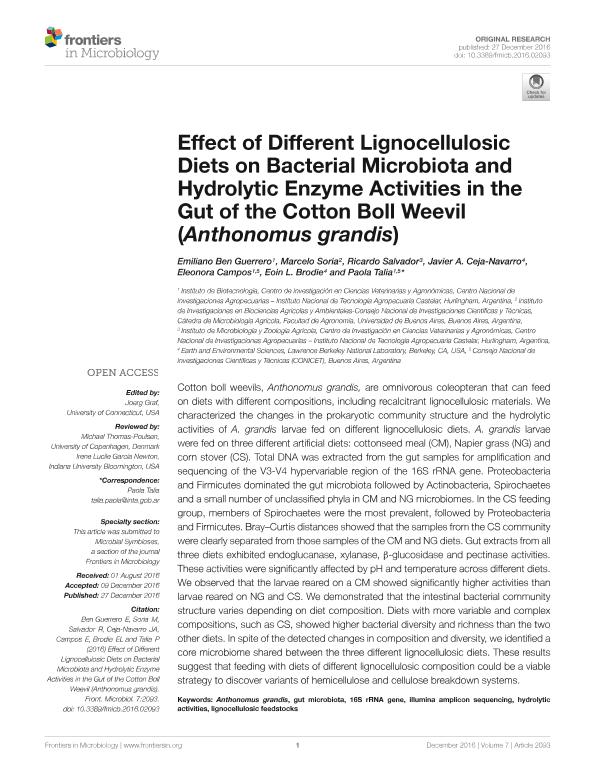Mostrar el registro sencillo del ítem
dc.contributor.author
Ben Guerrero, Emiliano

dc.contributor.author
Soria, Marcelo Abel

dc.contributor.author
Salvador, Ricardo

dc.contributor.author
Ceja Navarro, Javier A.
dc.contributor.author
Campos, Eleonora

dc.contributor.author
Brodie, Eoin L.
dc.contributor.author
Talia, Paola Monica

dc.date.available
2022-12-01T14:37:21Z
dc.date.issued
2016-12-27
dc.identifier.citation
Ben Guerrero, Emiliano; Soria, Marcelo Abel; Salvador, Ricardo; Ceja Navarro, Javier A.; Campos, Eleonora; et al.; Effect of different lignocellulosic diets on bacterial microbiota and hydrolytic enzyme activities in the gut of the cotton boll weevil (Anthonomus grandis); Frontiers Media; Frontiers in microbiology; 7; 2093; 27-12-2016; 1-13
dc.identifier.issn
1664-302X
dc.identifier.uri
http://hdl.handle.net/11336/179800
dc.description.abstract
Cotton boll weevils, Anthonomus grandis, are omnivorous coleopteran that can feed on diets with different compositions, including recalcitrant lignocellulosic materials. We characterized the changes in the prokaryotic community structure and the hydrolytic activities of A. grandis larvae fed on different lignocellulosic diets. A. grandis larvae were fed on three different artificial diets: cottonseed meal (CM), Napier grass (NG) and corn stover (CS). Total DNA was extracted from the gut samples for amplification and sequencing of the V3-V4 hypervariable region of the 16S rRNA gene. Proteobacteria and Firmicutes dominated the gut microbiota followed by Actinobacteria, Spirochaetes and a small number of unclassified phyla in CM and NG microbiomes. In the CS feeding group, members of Spirochaetes were the most prevalent, followed by Proteobacteria and Firmicutes. Bray-Curtis distances showed that the samples from the CS community were clearly separated from those samples of the CM and NG diets. Gut extracts from all three diets exhibited endoglucanase, xylanase, ß-glucosidase and pectinase activities. These activities were significantly affected by pH and temperature across different diets. We observed that the larvae reared on a CM showed significantly higher activities than larvae reared on NG and CS. We demonstrated that the intestinal bacterial community structure varies depending on diet composition. Diets with more variable and complex compositions, such as CS, showed higher bacterial diversity and richness than the two other diets. In spite of the detected changes in composition and diversity, we identified a core microbiome shared between the three different lignocellulosic diets. These results suggest that feeding with diets of different lignocellulosic composition could be a viable strategy to discover variants of hemicellulose and cellulose breakdown systems.
dc.format
application/pdf
dc.language.iso
eng
dc.publisher
Frontiers Media

dc.rights
info:eu-repo/semantics/openAccess
dc.rights.uri
https://creativecommons.org/licenses/by/2.5/ar/
dc.subject
16S RRNA GENE
dc.subject
ANTHONOMUS GRANDIS
dc.subject
GUT MICROBIOTA
dc.subject
HYDROLYTIC ACTIVITIES
dc.subject
ILLUMINA AMPLICON SEQUENCING
dc.subject
LIGNOCELLULOSIC FEEDSTOCKS
dc.subject.classification
Biología Celular, Microbiología

dc.subject.classification
Ciencias Biológicas

dc.subject.classification
CIENCIAS NATURALES Y EXACTAS

dc.title
Effect of different lignocellulosic diets on bacterial microbiota and hydrolytic enzyme activities in the gut of the cotton boll weevil (Anthonomus grandis)
dc.type
info:eu-repo/semantics/article
dc.type
info:ar-repo/semantics/artículo
dc.type
info:eu-repo/semantics/publishedVersion
dc.date.updated
2022-11-29T13:10:42Z
dc.identifier.eissn
1664-302X
dc.journal.volume
7
dc.journal.number
2093
dc.journal.pagination
1-13
dc.journal.pais
Suiza

dc.journal.ciudad
Lausanne
dc.description.fil
Fil: Ben Guerrero, Emiliano. Instituto Nacional de Tecnología Agropecuaria. Centro Nacional de Investigaciones Agropecuarias Castelar; Argentina
dc.description.fil
Fil: Soria, Marcelo Abel. Universidad de Buenos Aires. Facultad de Agronomía. Departamento de Biología Aplicada y Alimentos. Cátedra de Microbiología Agrícola; Argentina
dc.description.fil
Fil: Salvador, Ricardo. Instituto Nacional de Tecnología Agropecuaria. Centro de Investigación en Ciencias Veterinarias y Agronómicas. Instituto de Microbiología y Zoología Agrícola; Argentina
dc.description.fil
Fil: Ceja Navarro, Javier A.. Lawrence Berkeley National Laboratory; Estados Unidos
dc.description.fil
Fil: Campos, Eleonora. Instituto Nacional de Tecnología Agropecuaria. Centro Nacional de Investigaciones Agropecuarias Castelar; Argentina. Consejo Nacional de Investigaciones Científicas y Técnicas; Argentina
dc.description.fil
Fil: Brodie, Eoin L.. Lawrence Berkeley National Laboratory; Estados Unidos
dc.description.fil
Fil: Talia, Paola Monica. Instituto Nacional de Tecnología Agropecuaria. Centro Nacional de Investigaciones Agropecuarias Castelar; Argentina. Consejo Nacional de Investigaciones Científicas y Técnicas; Argentina
dc.journal.title
Frontiers in microbiology
dc.relation.alternativeid
info:eu-repo/semantics/altIdentifier/url/http://journal.frontiersin.org/article/10.3389/fmicb.2016.02093/full
dc.relation.alternativeid
info:eu-repo/semantics/altIdentifier/doi/https://doi.org/10.3389/fmicb.2016.02093
Archivos asociados
